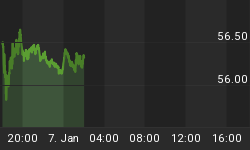To assess inflation, I don't rely upon flawed government numbers, like CPI. I create my own indicator from the price trends in crude oil, gold, and yields on the 10 year Treasury bond. I let the markets tell the story. With gold and crude oil surging this past week and with yields starting to move higher, inflation pressures are mounting, and typically, this a strong headwind for higher equity prices.
The Indicator
My inflation indicator is shown in figure 1 below a weekly chart of the S&P500.
Figure 1. Inflation Indicator
The indicator is constructed by looking at the strength and quality of the price trends in gold, crude oil and yields on the 10 year Treasury bond. To assess the trend, I use my proprietary price structure analysis indicator that looks at the current price relative to past pivot points and trend lines formed by those pivot points. These are the boxy looking indicators below the price charts in the members section at TheTechnicalTake.com. One such chart is shown in figure 2, a weekly graph of the yield on the 10 year Treasury bond. The price structure analysis indicator is turning up indicating that higher yields are likely in our future.
Figure 2. 10 year Treasury Yield/ weekly
Now let's return to figure 1 and our inflation indicator. We can see that the current value is in the danger zone indicating high levels of inflation, and the question then becomes: what does this mean for equity prices?
So let's design a study where we buy the S&P500 when the indicator reaches the danger zone, and we will sell our position when the indicator moves out of the danger zone. Very simple.
Since 1984, there have been 49 unique instances where the indicator has been in the high inflation or danger zone. If you were so smart to only buy the S&P500 during these periods, such a strategy would yield a negative 307 S&P500 points with 47% of your trades being winners. The equity curve for this strategy is shown in figure 3 (next page), and it should be obvious that being in the market when inflation is high (as defined by the indicator) is not a good strategy. Since 1984, there really is no single period where there is an edge to being in stocks when the trends in gold, crude oil, and Treasury yields are strong.
Figure 3. Equity Curve
Or to spin another way: strength in gold and crude oil and higher Treasury yields really does make a difference for equity prices.
The bottom line is this: high inflation, as determined by this indicator, is a significant head wind for higher equity prices.
Yet Sentiment Remains Bearish
Figure 4 (next page) is the Investor Sentiment Composite Indicator, and this is an indicator I have shown many times in the past. This indicator looks for extremes in the data from 4 different groups of investors: 1) Investor Intelligence; 2) Market Vane; 3) American Association of Individual Investors; and 4) the put call ratio.
As we can see from the figure, these investors are bearish, and history shows that when these investors are bearish we should be bullish. This indicator is one of the foundations of the Market Bias Timing System, which is a model that I have developed to keep me on the right side of the market trend.
The Market Bias Timing System is bullish.
Figure 4. Investor Sentiment Composite
So Am I Bullish Or Bearish?
We have two indicators and two different conclusions.
Our inflation indicator points to equities struggling, and the Market Bias Timing System is bullish because investor sentiment is so bearish.
So am I bullish or bearish? And how do we resolve these conflicting signals?
The answer is that I remain bullish as the Market Bias Timing System is bullish, and while the current bullish signal has not been robust, it is still not a failed signal. A failed signal is likely to have important implications for stock prices, and therefore, as investors and traders, we must have a clear understanding of what factors could lead to a failed signal, when a failed signal would occur and if that failed signal turns out to be a false signal requiring re-entry back into the market.
Subscribers to TheTechnicalTake.com will see what factors I am watching to help us navigate this treacherous market climate.
To learn more about our quantitative and disciplined investment approach please visit www.thetechnicaltake.com and sign up for our free weekly newsletter and downloads.















